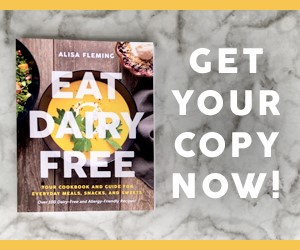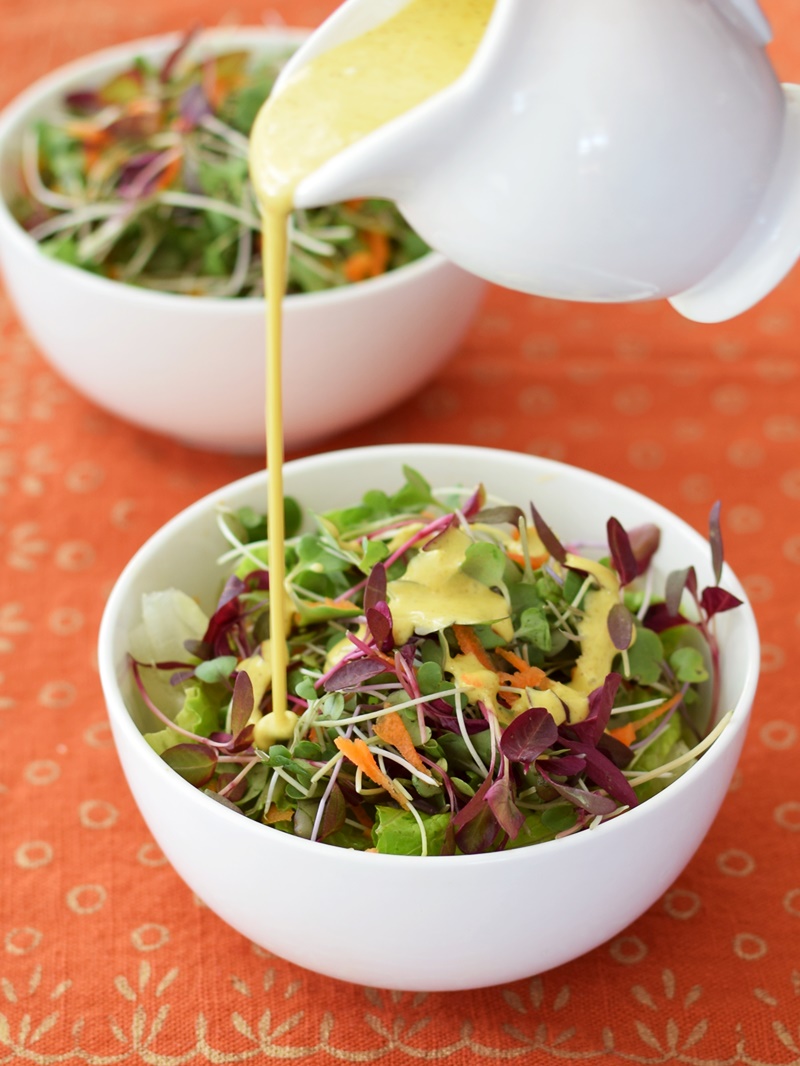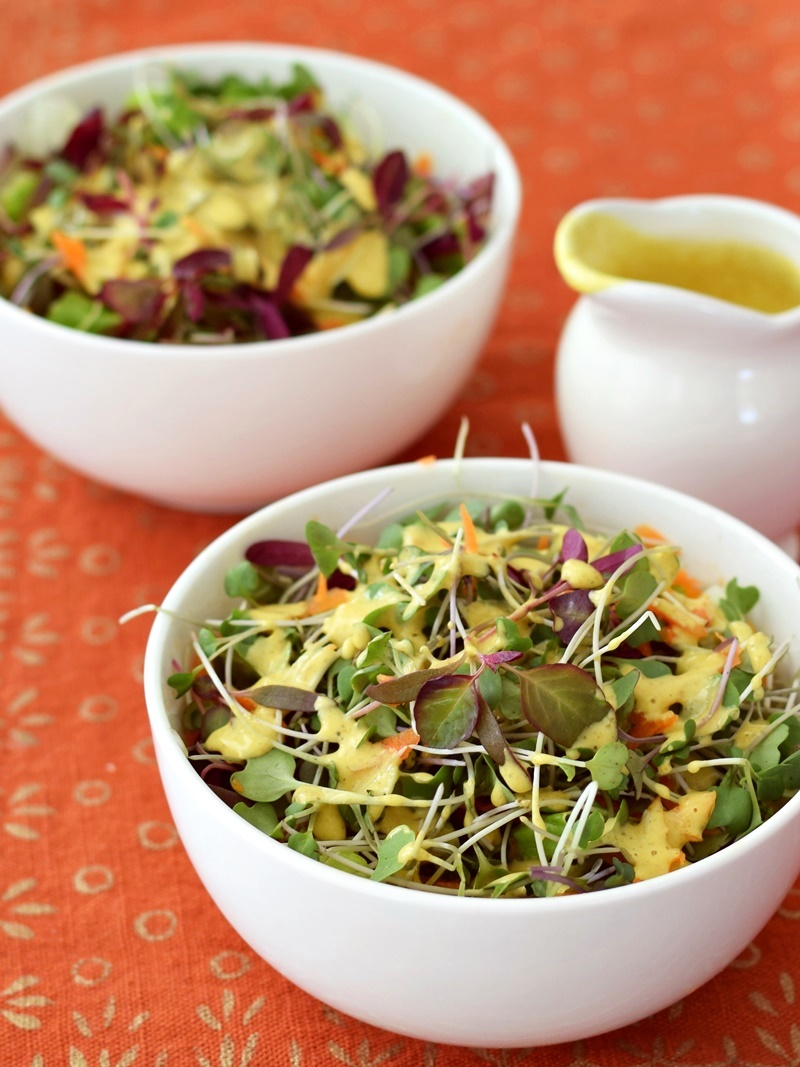 Here we are on the last day of our Dairy-Free Recipe Potluck – the 21-Day Dairy-Free Challenge starts tomorrow (you can join anytime)! To wrap things up, I have a healthy yet satisfying recipe from my own kitchen: creamy anti-inflammatory salad dressing.
Here we are on the last day of our Dairy-Free Recipe Potluck – the 21-Day Dairy-Free Challenge starts tomorrow (you can join anytime)! To wrap things up, I have a healthy yet satisfying recipe from my own kitchen: creamy anti-inflammatory salad dressing.
We’ve had quite a bit of dessert inspiration lately, but I know everyday life calls for scrumptious ways to enjoy savory foods, too. This creamy anti-inflammatory salad dressing delivers with just a little sweet, a little savory, a little tangy, a little spicy and a whole lot of satisfying and nutritious versatility.

It was over a decade ago that I first read about anti-inflammation in the book The Inflammation Syndrome by Jack Challem. The term has continued to pop up from time to time on healthy diet chats and posts, but this year, it’s really gaining steam. At the Fancy Food Show, foods like turmeric were abuzz and just last week, my husband’s doctor recommended he incorporate some more anti-inflammatory foods into his diet.
At first I was a little stumped on where to make changes – our diets seemed pretty solid as is – but then I remembered that the dressing on our daily big salads could use a healthy makeover. Rather than modify, I started from scratch with several nutrient-rich ingredients that I knew would go well together:
 Raw Cashews – Found in studies and observations to have protective anti-inflammatory compounds.
Raw Cashews – Found in studies and observations to have protective anti-inflammatory compounds.- Chia Seeds – These new darlings have a wonderful Omega ratio and are even pretty darn rich in calcium.
- Cashew Milk – Same goodness as cashews and it provides a little extra body and rich flavor.
- Apple Cider Vinegar – Beloved in natural circles, it is a more controversial food, but even the medical community recognizes it’s probiotic properties.
- Honey – Topically a fantastic inflammation fighter, and studies have shown equivalent potential for coating the throat. But strict vegans can substitute agave nectar!
- Ginger – Contains it’s very own potent anti-inflammatory compounds called gingerols – no joke!
- Turmeric – A new superstar against inflammation – shown to have positive effects in digestive conditions and battling cancer, too!
- Black Pepper – Helps to significantly increase the bioavailability of turmeric.
- Curry Powder – More ginger, turmeric, and pepper bundled with a smattering of other healthy spices.
- Mustard – Studies have shown that this ingredient can up the cancer-fighting skills of cruciferous veggies – a must if you serve the creamy anti-inflammatory salad dressing atop kale or broccoli. Plus, it rounds out the flavor.
And using this cashew milk and chia blend in place of typical mayo not only pumps up the nutrition, but it also leaves you with generously sized low-fat, oil-free servings – just 5 to 6 grams of fat per full 3 tablespoons! Enjoy this creamy anti-inflammatory salad dressing atop your favorite salad greens, or drizzle it over steamed cauliflower or potatoes. It can be served at room temperature, or if you opt to gently heat it as a sauce, note that it will thicken even more.
 The Dairy-Free Recipe Potluck is sponsored by So Delicious Dairy Free and the 21 Day Dairy-Free Challenge.
The Dairy-Free Recipe Potluck is sponsored by So Delicious Dairy Free and the 21 Day Dairy-Free Challenge.
Special Diet Notes: Anti-Inflammatory Salad Dressing
By ingredients, this recipe is dairy-free / non-dairy, egg-free, gluten-free, grain-free, peanut-free, soy-free, vegan / plant-based, vegetarian, and mostly paleo (easily adaptable for strict paleo).
- ¼ cup raw cashews
- 1 tablespoon chia seeds (use white for a lighter color)
- ⅔ cup So Delicious Dairy Free Unsweetened Cashew Milk
- 1 tablespoon apple cider vinegar
- 1 tablespoon raw honey (use agave nectar for strict vegan)
- ½ teaspoon ground turmeric
- ½ teaspoon fresh minced ginger
- ½ to ¾ teaspoon curry powder, to taste (I used Trader Joe's - the full amount)
- ⅛ teaspoon mustard powder
- ⅛ teaspoon salt
- ⅛ teaspoon black pepper
- Place the cashews and chia seeds in a spice grinder or small food processor and grind into a powder. It's okay if it begins to clump.
- Put the cashew-chia mixture in your blender with about half of the cashew milk. Blend until smooth, about 30 to 60 seconds.
- Add the remaining cashew milk, vinegar, honey or agave, turmeric, ginger, curry (to taste), mustard, salt, and pepper. Puree for about 60 seconds more, or until nice and smooth. Taste, and adjust seasonings, if desired.
- For maximum thickening and to let the flavors meld, chill for 30 minutes, and then briefly blend or whisk before pouring atop your salad. Can be gently heated and served with steamed vegetables, if desired.


60 Comments
I’m allergic to penicillin and other types of mold. Cashews and peanuts used to make me pretty ill….as they are covered with mold you can’t see. I read an interesting suggestion that if you soak them for 10 minutes in powdered Vitamin C (ascorbic acid), it will kill the mold. It worked for me…no more stomach aches and skin rashes! Wanted to share this to help others. BTW…jarred Peanut butter has the highest concentration of mold.
Can i put this on pasta as a hot dish? Looking for a sauce without tomatoes, carrots and beets. Thank you
So sorry for my delay Arlene, I missed your question! Yes, you can use it on a hot dish. I’ve never tried it heated, but functionally, it will work!
I can’t do cashews peanuts what can you replace it with for this recipe
Without testing, I can’t give you a firm answer. But you can try coconut cream or another nut (macadamias will probably work well). Sunflower seeds work in theory, but they do have a pronounced taste.
This looks so good! However, cashews give me migraines. Wondering if I could substitute almonds and unsweetened almond milk?
You can substitute cashews. It will affect the flavor and consistency a little.
Alisa, I just made this dressing/sauce, I am going to put it on my Salmon that I am making for dinner. I just tasted it with a spoon, and it tastes really good, but there is. slight bitterness to it that I don’t like, could that be the dry mustard? If so, I would just eliminate the mustard next time. Also couldn’t find sugar free cashew milk, but the cashew milk I got only had 2 grams of sugar in an entire cup, that shouldn’t affect anything, should it?
Hi Robin, it could be the mustard – they do vary, I have bought one that was a little bitter before. However, it might be the curry or turmeric. Those both have a bitterness to them that some people really detect. To cut it, you can lightly saute the spices in a little bit of oil before adding to the recipe. I use very moderate amounts of turmeric myself because I find it bitter, but you might be even more sensitive than me!
Thank you for your quick reply. I love curry and drink turmeric tea, so don’t think it is either of those. I will try cutting the mustard in half and see if that makes a difference. I am thinking maybe cutting the turmeric and upping the ginger as well. Thanks for your feedback.
Keep in mind, curry and turmeric are less bitter when heated / cooked. They are raw in this recipe, so are a little bitter.
Does this dressing help acid reflux? The ingredients seems to cause acid reflux. Like mustard and spices.
I would consult your physician to find out what foods and products help with acid reflux.
What would you suggest to substitute cashews? I’m allergic to cashews
I haven’t tested it, so it’s hard to say (in terms of both flavor and richness), but you could try replacing the cashews with coconut cream, oil (a neutral-tasting one), or another nut, like almonds or macadamias.
Hi
I need a salad dressing that is dairy free and vinegar free …..has anyone ever left out the vinegar in the recipe?
Thanks
Lemon juice would probably substitute well for the vinegar.
Could I use pine nuts in place of cashews?
I haven’t tested it, but probably. Pine nuts aren’t as neutral in flavor, so it will influence the taste a bit, and they are oilier, so they might not thicken it as much. But I still think they would work.